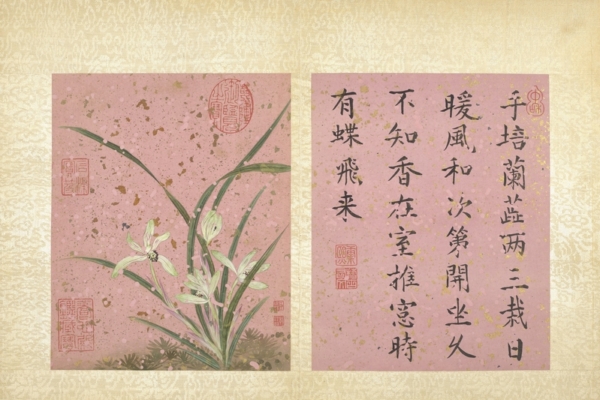In the midst of the scorching summer, the National Palace Museum in Taiwan has launched a special exhibition titled “The Emperor’s Mobile Garden – Qing Dynasty Court Floral Paintings,” running until September 22, welcoming visitors to come and explore.
The National Palace Museum in Taiwan stated that the summer exhibitions in its northern branch are vibrant and lively. The special exhibition “The Emperor’s Mobile Garden,” centered around Qing Dynasty court floral paintings, showcases the royal gardens of the 17th and 18th centuries with botanical specimens and floral photos. Alongside this, there are family-friendly flagship activities like the “Palace Children’s Festival,” themed around a summer garden, offering a range of enriching activities such as exhibition hall exploration, themed itineraries, summer camps, and large-scale family nights. Both children and adults are invited to enjoy the colorful world of the royal gardens.
Director of the National Palace Museum in Taiwan, Xiao Zong-huang, emphasized the museum’s recent focus on children and teenagers. Apart from offering diverse educational activities during school holidays, the curatorial direction has also been adjusted to explore the significance of the museum’s collections from various perspectives. The special exhibition “The Emperor’s Mobile Garden” delves into the rich Qing Dynasty court floral paintings, examining how botanical species information was collected, established, and documented through texts and images. The flowers depicted in these paintings originate from temperate, subtropical, and tropical regions, reflecting the multidimensional aspects of cultural, artistic, and scientific exchanges between East and West.
Xiao Zong-huang expressed special gratitude to the scholars and experts from the National Taiwan University Herbarium and the Forestry Experimental Institute of the Ministry of Agriculture for scientifically assisting in identifying the plant species in the paintings. They provided specimens and floral photos to enrich the exhibition content, presenting the allure of seasonal flowers from interdisciplinary perspectives of art, history, botany, and ecology, allowing the audience to revel in the delightful world of art.
The National Palace Museum in Taiwan mentioned that this summer, in conjunction with the “The Emperor’s Mobile Garden” exhibition, they have specially designed the “2024 Palace Children’s Festival” for children and families.
Deputy Director of the museum, Huang Yong-tai, likened the National Palace Museum to an enduring and diverse artistic treasury, welcoming children to create their own artistic gardens within the museum, fostering unforgettable memories, igniting children’s interest in cultural artifacts, cultivating artistic imagination and critical thinking, while enjoying quality family time in the summer. Throughout the event, daily interactive game booklets exploring the exhibition titled “The Flower Spirits’ Party” in both Chinese and English are provided free of charge, inviting children from around the world to explore the vibrant floral treasures of the museum together.
Deputy Director of the National Palace Museum in Taiwan, Yu Pei-jin, mentioned in her introduction to the exhibition that according to the museum’s 2022 survey of audience opinions, over half of the respondents believed that visiting the museum allows them to learn new things. She expressed the museum’s joy at this feedback while also acknowledging the need to respond prudently to these expectations. Learning has various avenues, and exhibitions are one of them. This exhibition, curated by the museum’s new generation of curators and led by Assistant Researcher Su Ya-fen, is based on her master’s thesis, combining the museum’s collections to develop the theme of the exhibition.
Yu Pei-jin emphasized that from a learning perspective, the curator must engage in dialogue and learning with the artworks to incorporate academic research findings into the exhibition. Feedback from the audience is another form of learning. Therefore, learning from the artworks and engaging with the audience are crucial aspects of the curator’s work, encouraging the museum’s curators to continue striving in this direction.
Assistant Researcher Su Ya-fen from the Museum’s Painting and Calligraphy Department stated that while flowers may only bloom briefly, through brushstrokes, their beauty and vitality can be perpetually preserved. The Qing Dynasty court floral paintings not only serve as visual records of transplanted flowers but also as “mobile gardens” that can be appreciated at any time, unrestricted by season or region. The exhibition focuses on Emperor Kangxi, who enjoyed observing flora and fauna during his journeys and Emperor Qianlong, who loved composing poetry, exploring how the artists created colorful court floral paintings based on the emperors’ preferences and requirements.
Su Ya-fen pointed out that Emperor Kangxi often had court officials observe the flora and fauna on the roadside during breaks on his journeys, explaining their characteristics and uses, acting as a kind of “Imperial guide.” These plants from the regions outside the Great Wall, such as golden lotus, golden peach, wild poppy, greenfinch, wild chrysanthemum, became new subjects in Qing court floral paintings, recorded in the “Comprehensive Handbook of Flowers” compiled during the Kangxi era (similar to a modern encyclopedia of flowers). This handbook also served as a vital reference for Emperor Qianlong’s flower-themed poems.
The National Palace Museum in Taiwan highlighted captivating exhibits such as the national treasure “Qing Painting Court – Paintings of Twelve Monthly Living Scenes,” dating back to the Qianlong era, portraying the ideal life in a garden based on the twelve months of the lunar calendar. The selected paintings depict February, April, June, September, and December, showcasing the four seasons of spring, summer, autumn, and winter respectively. The blooming flowers in the painting symbolize harmonious weather patterns and world peace, reflecting the emperor’s ideal garden.
One outstanding piece is the painting “Sea West Collection of Flowers,” created by court painter Yu Sheng under the decree of Emperor Qianlong in the 22nd year of his reign (1757). It portrays eight flower species commonly seen in European gardens introduced by Jesuit missionary Johan Adam Schall von Bell, used to adorn the Western-style flower garden Emperor Qianlong was constructing at the Yuanmingyuan Palace. After the missionary’s passing, there are no records of these Western flowers being cultivated or propagated within the palace, making “Sea West Collection of Flowers” a precious witness to the fleeting presence of these Western flowers in the Qing era.

